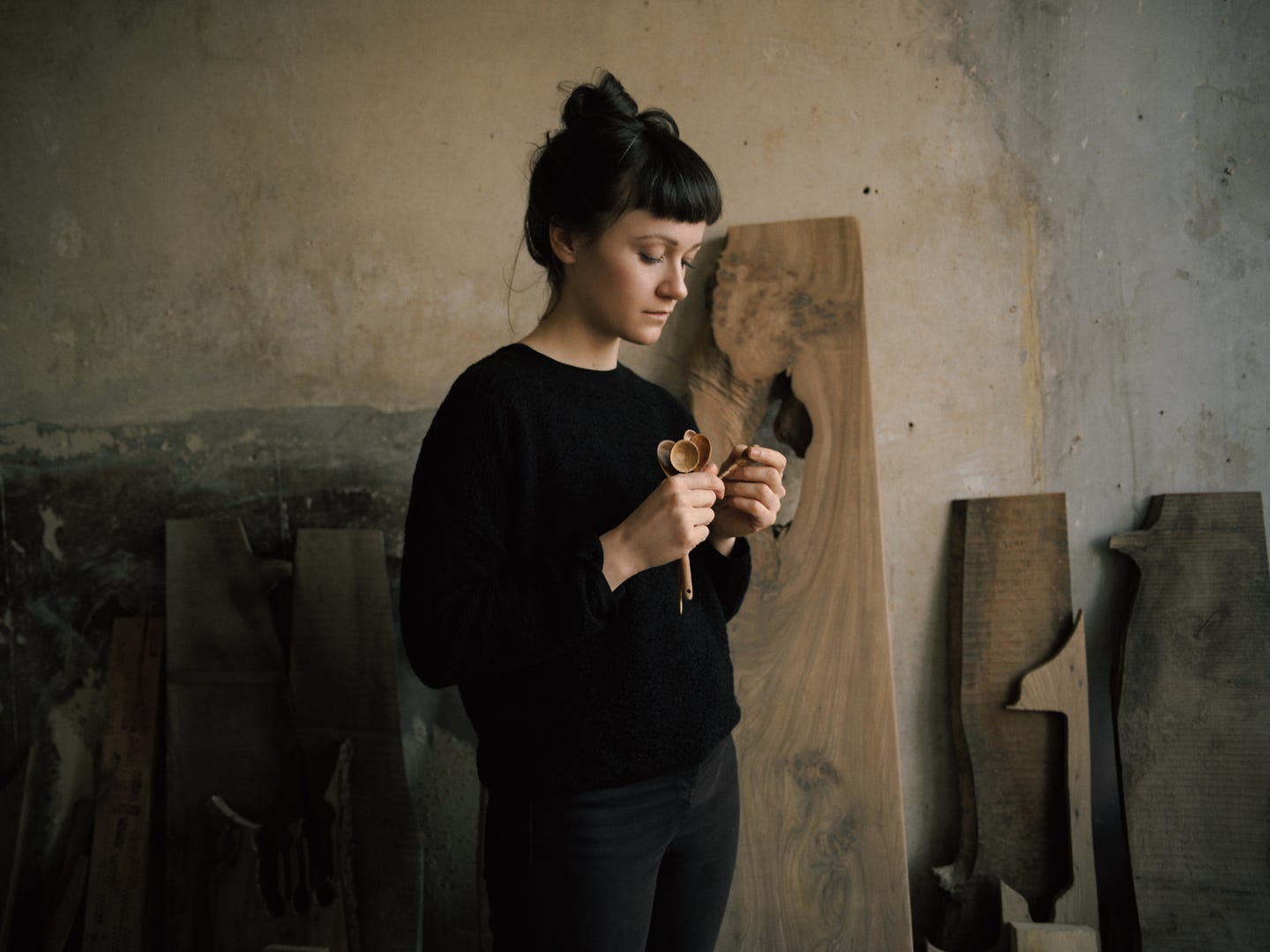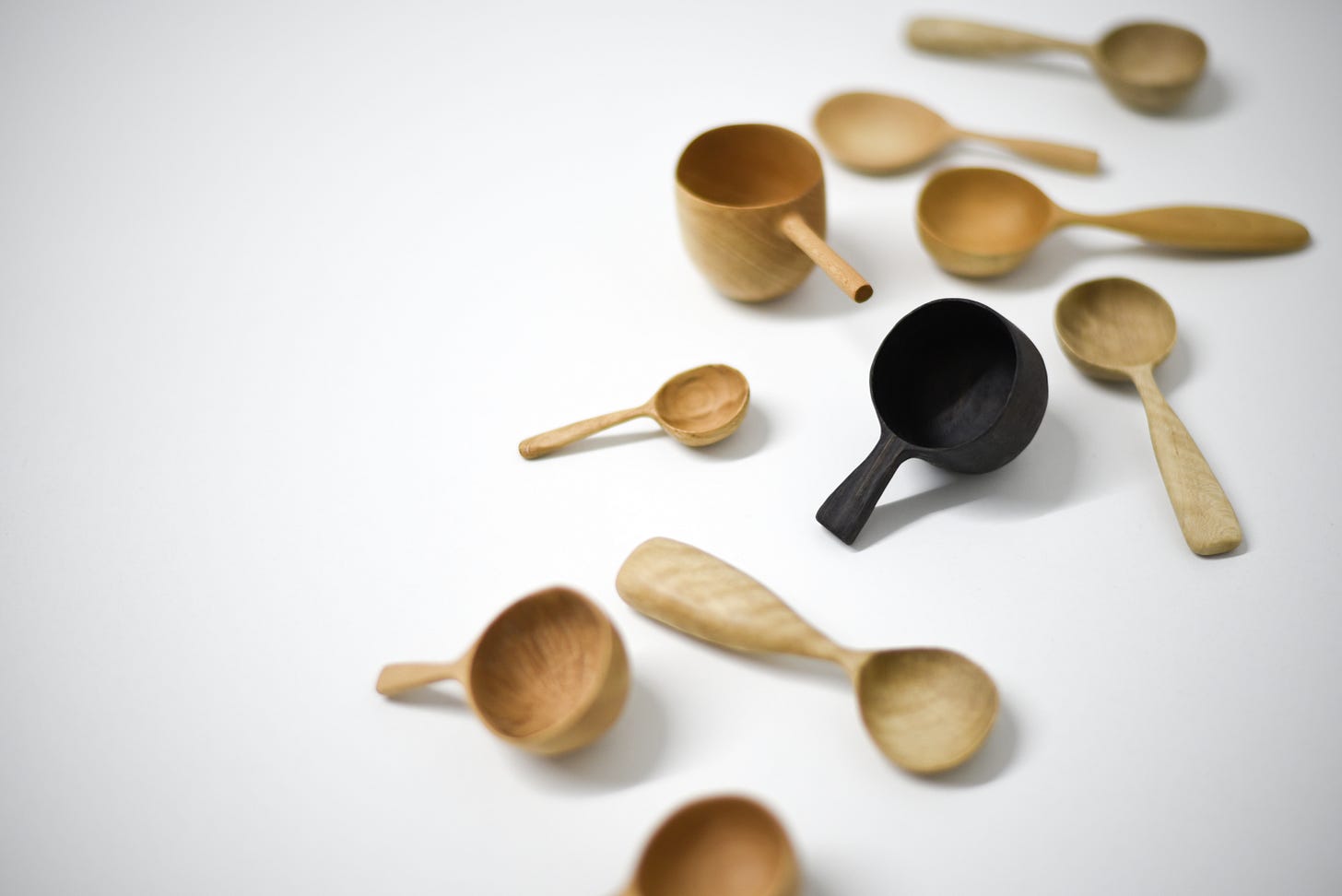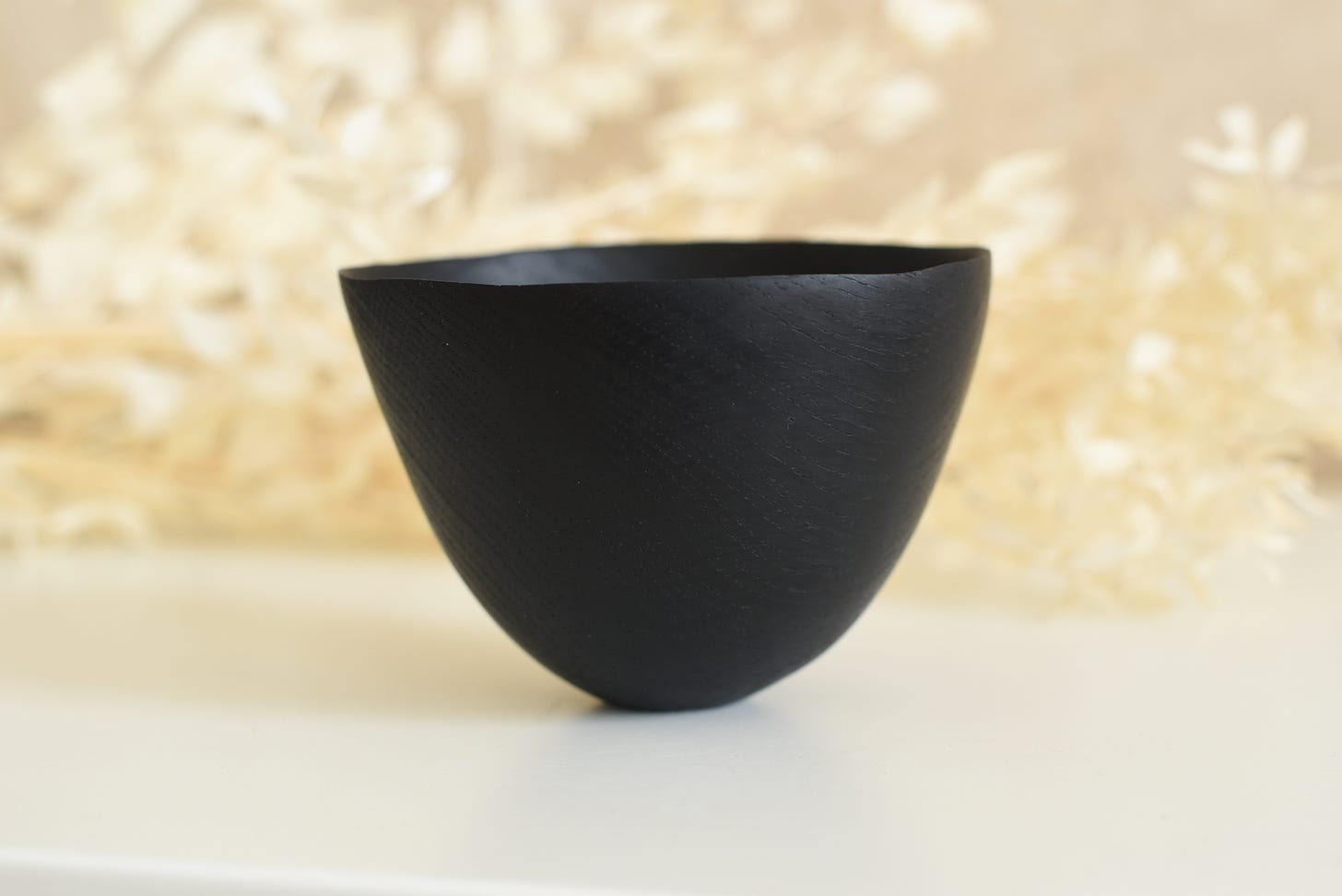Thanks for reading On Hunger, my newsletter exploring food and desire. It goes out every other Wednesday; each edition features a recipe and a conversation with someone doing something interesting in and around the world of food. This week, we’re heading north and taking a risk. If you like what you read, follow me on Instagram, or share this with a friend.
Six years ago, I packed my things into a small van, hugged my Clapton flatmate goodbye, and set out on the long road to a new life in Glasgow. My then boyfriend, Ross, was at the wheel, and I knew I was taking a risk. I wanted our life together to feel like an adventure. It wasn’t the first time I’d turned my world upside down, but it felt different somehow. I’d made a home in London, settling there after a wild 18 months working in Asia. I felt uprooted, thrown to the wind – but there it was, tantalisingly within reach: the promise of love.
There’s no happy ending to this story. Glasgow – cold, wet, grey, Glasgow – had never been top of the list of places I wanted to call home. I knew I would struggle, but I hadn’t factored in the small, daily grind of a cohabitation I’d had little say in, or the fundamental incompatibilities that would see the relationship unravel over two painful years.
Our experiment might have been sterile, but there was much to admire in the fertile, rain-soaked streets of Glasgow. Low rents, a thriving arts scene and a strong community spirit meant anything, it seemed, was possible. The food scene, we joked, was 10 years behind London – the foodie enclave of Finnieston was just discovering small plates – but exciting things were happening in the Southside, where we lived. Anna and Sam Luntley opened (then closed) Bakery47, a neighbourhood-defining venture stocked with all things Kinfolk and sourdough. Panjabi deli Ranjit’s Kitchen rustled up devilishly good daal, samosas and gulab jamun. Locavore sold veg boxes, bulk pulses and living Christmas trees; fried fish came with a side of tomato rice at Hooked; Claire dressed vegan plates at Male Carne; Malaysian grub, eventually, reached Queen’s Park at Julie’s Kopitiam.
I rented a space at Mount Florida Studios, a creative workspace set up and run by plucky, stubborn (her own word) Catherine, this week’s interviewee. She was, and still is, an inspiration: someone resolutely forging her own path, often against the odds. I covered my studio walls in jungle drawing, wrote, drew, and dreamed of warmth and sunshine. At home, I planted seeds and baked pineapple cake, as much for the look of joy on Ross’s face as the scent of coconut and caramel wafting from our tiny kitchen. We’d curl up together and scoff it still warm from the oven – happy together, if only for a little while.
This week…
Shop at Harringay Local Store
Sharpen your knives at Kitchen Provisions
Read Qualities of Earth

Upside-down pineapple cake
I make this all the time. It’s quick, comforting and nostalgic: a golden, retro ring of pineapples over a simple quatre-quarts sponge (equal quantities of eggs, sugar, butter and flour). Make the base (or topping?) your own: swap the fruit for whatever you have at hand, add nuts or a splash of rum, go for classic candied cherries. Lately I’ve wondered whether freshly plucked rosemary would work in the caramel – something to try in the next iteration. You’ll need a non-stick springform cake tin – my 24cm one fits six pineapple rings perfectly.
For the topping
50g of salted butter
100g of dark brown sugar, or better yet palm sugar
50g of desiccated coconut
One small can of pineapple rings, drained, juice reserved
For the batter
3 large eggs
200g of salted butter, melted
200g caster sugar
200g self-raising flour
Preheat the oven to 180C (160C for a fan oven).
In a small saucepan, melt the butter, sugar and a splash of the pineapple juice together on a medium heat, stirring constantly. When the mixture bubbles and starts to darken and thicken, stir in the coconut, pour it into your cake tin, and spread it around so it covers most of the base. I often prepare the caramel directly in the tin placed on the hob, though this might work best with an electric hob. Arrange the pineapple slices over the warm caramel and set aside.
Whisk the eggs and caster sugar together until they’re thick and fluffy. Add the flour and melted butter and mix well. Pour this batter on top of the pineapple. Bake for about 35–45 minutes, or until a skewer comes out clean. Release the cake from its steel embrace before the caramel has a chance to cool and harden, place a plate face down on it and flip the whole thing over. With any luck, you’ll have a pineapple-crowned glory to admire. It’s excellent when warm, but arguably even better after a couple of days, when the pineapple juices have had a chance to seep into the cake.

Meet… Catherine Johnston, Object Company
When I think of Catherine, I think of wood shavings and the soft, smooth surface of hand-sanded wood. I think of her aesthetic – pared-down, earthen, textured – and the desirable utensils, cutting boards and vessels she creates for her business, Object Company. She also runs Mount Florida Gallery & Studios, a multi-disciplinary space for creatives. We hadn’t spoken in years, so our catch-up took many turns, from Glasgow’s notoriously turncoat weather to the planting of seeds in communal gardens. I’ve condensed it here to keep things simple – a quality that’s always moved me in her work.
Let’s start by going way back. How did you get started?
I started off as a painter. I studied in Edinburgh and found myself drawn to creating the surface to paint onto, building stretchers… I wasn't interested in precision, I was just interested in the objects that came out of it. So that was quite a big thing. Down the line, I found myself in a situation where painting felt quite indulgent. I realised that I wanted to make practical things that had a use and a justification for existence.
Did you feel that painting was frivolous in some way?
I felt like that, yeah. I think that’s when I realised that I needed to move away from it. If I was feeling like that, then it probably meant that it wasn't quite right. And I have such an appreciation of painting and painters. Maybe I was just a bit stubborn. You know that thing where you go to art school, and a lot of friends quickly stop creating work and become teachers and, you know, choose a different career… I felt I had to continue, because it was what I'd studied. Realising that's not necessarily the case was quite helpful.
What was the first thing you made?
A spoon. It’s such an accessible thing to be able to make. If you’re working with wood, you can create something like that, which has a use but is also very satisfying to make. Something you can make with just one knife, you know. You don’t need loads of kit. That was really appealing. You can make, like, a spoon for a baby – it’s such a meaningful thing, it’s ceremonial. People get so much joy out of things like that. I didn’t realise that people were so obsessed with spoons. People collect them. I wasn’t one of those people.

I used to steal teaspoons. I sometimes still do.
Ah, you’re one of them! I do get it. My mum had a spoon collection, with all these crests from golf clubs, I think it was. There’s a simplicity to a spoon. Concave surfaces are a little bit trickier to create. It makes you think about how things are made, and why. And so that was the first thing I made.
When was that?
I think it was 2012, around the time I discovered Instagram. It’s not a particularly glorious story. There were women working with wood who were making things I found very beautiful. It was a massive, massive influence, and it still is. I guess it was seeing people similar to myself doing things I didn’t think were doable for me before. And then spoons just became what I was known for. Now I’m kind of… not moving away from that as such – I’m still creating concave objects that can be used. But at the moment I’m working towards a couple of exhibitions, which is the first time I’ve ever done that. I want to show larger vessels, and things I’ve been working on that are pushing that boundary between having a use and being just objects in their own right. I still really enjoy creating things like coffee scoops that give people joy every day, but I also have this breadth of practice.

Does living somewhere like Glasgow (cheap, experimental) give you that luxury?
Absolutely. That’s the only reason I’m able to do what I do. It’s a bit of a different set up as you know. Things haven’t quite connected up like they have in London. There are all these plots in the periphery, where people are just sitting on properties until they’re in demand for something else. Access isn’t always possible, but there’s always scope to set something up.
What’s changed at Mount Florida Studios?
I've been saving up for a pottery wheel for the last year and I've just ordered it. I’ve got this stoneware kiln that I’ve managed to get for £300 from this old guy out in Ayrshire. I’m interested in porcelain – much higher firing temperatures and much more delicate. Things are more simplified now. There’s fewer people in here. I have more space to work myself, and although it’s a big space I’m finding that I’m using every inch of it. Having things plugged in all the time – it’s just an easier way to work. Space is so important, and so in demand.

There’s something about allowing yourself that space, rather than offering it to others in exchange for financial stability.
Exactly. I feel significantly better about just making work and being able to cut stuff out, and not worry about making dust while someone else is using the space. I hadn’t realised how much of a difference it would make. This year is going to be good. And I’m really appreciative and grateful that the studios got that grant. There’s a bit of money sitting there, and if anything comes up, I have that security.
Which grant?
It’s for businesses renting properties. We were eligible for a £10,000 grant. For a little business like mine, it’s changed everything. I was in disbelief. The difference just a little bit of financial support makes!
It’s so difficult being a creative without that structural support behind you. Living with that fear all the time – it takes its toll.
It’s just that space, you know… that kind of creative space to be able to actually figure out what your priorities are. Just that little bit of breathing space – I hadn’t realised how important that is to people. So many people are in a way worse situation than I am. I’ve obviously found it quite stressful and not realised. Universal basic services have been coming up a lot recently – imagine what something like that could do for everyone. I feel guilty about that, so many people have had such a shit time. I’ll try and use the grant wisely, to contribute something. What I’m making, it’s not changing the world. And I think just remembering that – that’s refreshing, you know. I need to remember that.
Catch Catherine’s work at the London Craft Week this October, or in December at Pavilion Pavilion, an experimental gallery run in Glasgow by artist Jack Brindley. Object Company is sold out at the moment, but you can keep an eye on Instagram for the next stock announcement.
That’s it for today. Coming up soon: dumplings, deep frying and durian.



